ALLIED RAID AT DIEPPE, FRANCE, ENDS IN DEBACLE
Dieppe, German-Occupied France • August 19, 1942
Ever since the German Wehrmacht (armed forces) had launched its surprise Blitzkrieg on the Soviet Union in June 1941 (Operation Barbarossa) the Allies had been sensitive to Soviet dictator Joseph Stalin’s increasingly desperate appeals to Western leaders to open a “second front now” in Northwestern Europe. British Prime Minister Winston Churchill glommed onto the idea of a large-scale seaborne raid, or a “reconnaissance in force,” on the cross-Channel port-cum-holiday resort of Dieppe in Northern France.
The Dieppe raiding force consisted of roughly 5,000 mostly untested Canadians and a much smaller commitment of 1,057 British troops and newly formed Royal Marine Commandos. Embedded in the front line of the Royal Marine Commandos were 30‑odd volunteers of the Intelligence Assault Unit who were about to become known as Lt. Cmdr. Ian Fleming’s Commandos (aka 30 Commando)—the same Fleming who would later create the fictional British secret service agent, James Bond. The prize of Fleming’s men was the Enigma cypher machines used to encode and decode German naval signals traffic, as well as coding tables and lists of settings kept in the German naval headquarters located in a Dieppe hotel. Fleming’s unit, if successful, would buttress what the 34‑year-old intelligence officer privately believed was a ridiculously lame venture. Surprisingly, this detail of the Anglo-Canadian raid has only come to light in recent years. Augmenting the raiding party were 50 U.S. Army Rangers, several Royal Air Force squadrons, and a handful of Free French commandos. The Dieppe raid’s architect was recently appointed Chief of Combined Operations Headquarters, Vice Adm. Louis Mountbatten, a can-do glory-hunter for himself and his organization.
In the predawn hours on this date, August 19, 1942, the mainly Anglo-Canadian force launched Operation Jubilee, an operation compromised the week before by a British Special Operations Executive (SOE) double agent on the payroll of the German Abwehr (military intelligence). Miles from landfall, the Allied flotilla was “discovered” and a British gunboat leading the LSIs (Landing Ship, Infantry) got the worst of it in an exchange of gunfire with armed German trawlers. The LSIs scattered for safety and were unable to be at the right sector of the invasion beaches at the right time. Allied surprise lost, the Germans scrambled to man their defensive positions in preparation for the approaching landings.
When the invaders managed to reach the six narrow landing beaches, four in front of the town itself and two on the eastern and western flanks, they were pinned down by unexpectedly lethal and accurate machine gun, rifle, and artillery batteries. Twenty-seven tanks that disembarked from Royal Navy craft were destroyed as soon as they came ashore. Near Puys (Blue Beach), one of four color-coded beaches adjacent to the town, just 60 out of 556 men of the Royal Regiment of Canada survived to return to England. Two hundred Royals were killed, pinned against the seawall and the cliffs above, and 264 captured.
At 11 o’clock the withdrawal began. It was completed by 2 p.m. Losses from the daredevil raid included 3,367 Canadians (killed, wounded, or taken prisoner), 275 British commandos, and 3 U.S. Rangers. The casualties represented almost 60 percent of the 6,086 men who made it to shore. The Royal Navy lost one destroyer and 33 landing craft out of 237 vessels, suffering 550 dead and wounded. The RAF, spoiling for combat over the French coast, lost 106 aircraft (92 killed and wounded out of some 10,500 participants) to the Luftwaffe’s 48 aircraft. For the RAF it was the worst single day of losses in the war. German Army casualties were 591 out of roughly 1,500 men.
Dieppe grabbed Adolf Hitler’s attention. The Fuehrer ordered a speedup in constructing the Atlantic Wall along the Channel coast. To the Allies, Dieppe proved the need for better intelligence as well as the futility of making an unimaginative frontal attack against a well-defended port. Future Allied attacks, both in the Mediterranean (Operation Torch, Operation Husky, and Operation Dragoon) and cross-Channel (Operation Overlord), were conducted in remote locations by extremely powerful landing forces supported by heavy and concentrated air and naval bombardment right up to the waterline. Still, it’s open to debate whether the high degree of senseless slaughter, tactical blunders, and ill-fated miscalculations at Dieppe was a tragic albeit essential dress rehearsal to the successful 1943 and 1944 invasions of Western Europe as Mountbatten and his admirers have argued.
![]()
Operation Jubilee: Audacious Hit-and-Run Raid on Dieppe, German-Occupied France, Turns Into Allied Rout
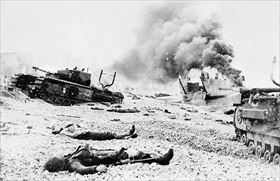 | 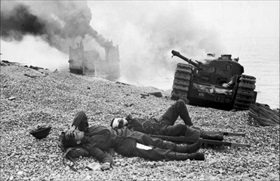 |
Left: In the aftermath of the Dieppe Raid on August 19, 1942, abandoned Churchill tanks and dead Canadian soldiers (perhaps members of a demolition team) lie on the edge of pebble-strewn Blue Beach, which was situated at the foot of a sheer cliff. Nearly 60 brand-new Churchill tanks were allocated to support the infantry and commandos, to be put ashore by landing craft. Several of these heavy tanks in each of the four invasion “waves” were lost on or before reaching shore. Only 14 got off the pebble beach and past the seawall. Although the tanks were effective in engaging the defenders in the town’s buildings, their progress was blocked by concrete barriers; the demolition teams proved unsuccessful in accompanying the tanks. Some tanks were able to return to the beach once a withdrawal was ordered but none was taken off. Hitler was thankful that the Allies had left a hefty arsenal of weapons on the beaches, which provided the Wehrmacht with a close-up study of enemy weaponry.
![]()
Right: Canadian wounded and abandoned Churchill tanks lie on Dieppe’s beach after the abortive raid in the Normandy region of Northern France. The tracks of most of the Churchill tanks were stripped as they were driven on to the pebble beach, and the bogged-down vehicles became sitting ducks for withering German antitank guns. Tanks that did cross the seawall were stopped by concrete roadblocks. A landing craft is on fire in the background.
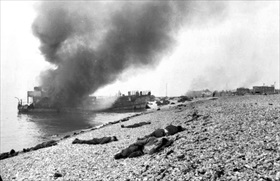 | 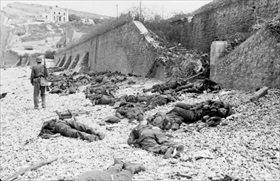 |
Left: Destroyed landing craft on fire with Canadian dead on the beach. The steep beach gradient can clearly be seen. A concrete gun emplacement on the right covers the whole beach. A pre-invasion bombardment of the beachfront had been planned from the beginning, but it was canceled due to the fear of harming French civilians and perhaps dampening a friendly reception to the Allies’ invasion of Vichy-held French North Africa, Operation Torch, less than three months away.
![]()
Right: Canadian dead from the 1st Battalion, the Royal Regiment of Canada lie where they fell on Blue Beach near Puys. Trapped between the beach and Dieppe’s high sea wall fortified with barbed wire, the Canadians made easy cross-fire targets for German machine gunners raking the beach from hardened bunkers, whose positions in the cliffs on either side of the town had gone unnoticed by raid planners. Only 6 percent of the men who landed on Blue Beach returned to Britain. Although it is extremely difficult to see in this image, a bunker’s firing slit appears as a dark line just above and to the left of the head of a German soldier walking along the beach. Supporting fire by Allied naval destroyers was far too light to have much effect.
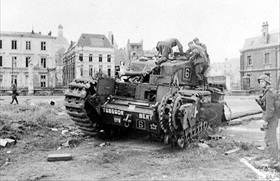 | 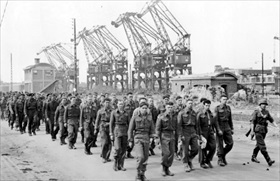 |
Left: German soldiers examine a Churchill tank at Dieppe, August 19, 1942. The Germans decided to reward the townspeople for not helping in the Anglo-Canadian raid—this by freeing French POWs originating and living in Dieppe before the Franco-German Armistice of June 21, 1940. To the delight of Marshal Philippe Pétain, head of the collaborationist French government, a train carrying around 1,500 French POWs arrived at Dieppe on September 12, 1942. Additionally, Hitler gave Dieppe’s citizens a gift of 10 million francs to use in repairing damage caused during the Anglo-Canadian raid as a reward for what he called the town residents’ “perfect discipline and calm.”
![]()
Right: Anglo-Canadian POWs at Dieppe are marched away from the port area. News media in Britain and the United States reported that the Allies had staged a successful raid on the enemy coast and hinted that Dieppe had served as a dress rehearsal for a much larger and more ambitious invasion in the future. They played down the casualties and losses of the operations. Prime Minister Churchill summed up the Dieppe raid this way: “Honor to the brave who fell. Their sacrifice was not in vain.”
The Dieppe Raid: Ominous Dress Rehearsal for Operation Overlord
![]()

 History buffs, there is good news! The Daily Chronicles of World War II is now available as an ebook for $4.99 on Amazon.com. Containing a year’s worth of dated entries from this website, the ebook brings the story of this tumultuous era to life in a compelling, authoritative, and succinct manner. Featuring inventive navigation aids, the ebook enables readers to instantly move forward or backward by month and date to different dated entries. Simple and elegant! Click
History buffs, there is good news! The Daily Chronicles of World War II is now available as an ebook for $4.99 on Amazon.com. Containing a year’s worth of dated entries from this website, the ebook brings the story of this tumultuous era to life in a compelling, authoritative, and succinct manner. Featuring inventive navigation aids, the ebook enables readers to instantly move forward or backward by month and date to different dated entries. Simple and elegant! Click 











